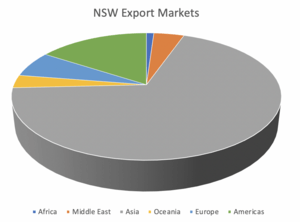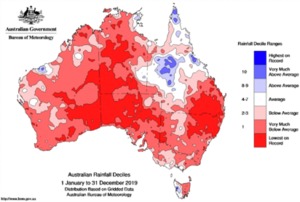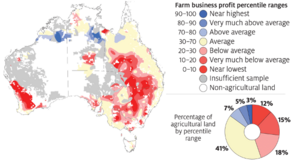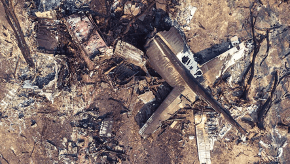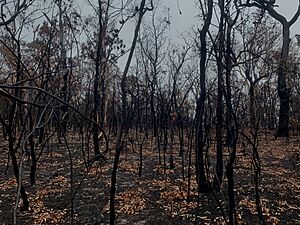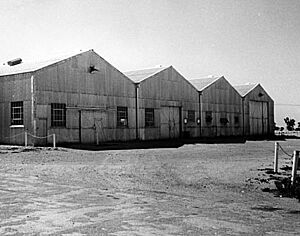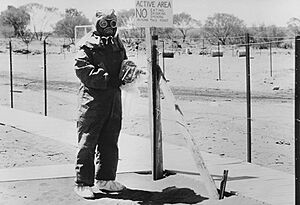Southern Australia facts for kids
Quick facts for kids
Southern Australia
|
|
|---|---|
|
Region
|
|
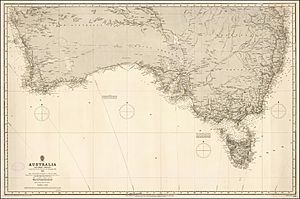
Southern Australia, generally defined as latitude 26 degrees and below
|
|
| States | NSW, Victoria, ACT, South Australia, Tasmania, southern Western Australia, |
Southern Australia is a big part of the Australian continent. It includes the states of New South Wales, Victoria, Tasmania, the Australian Capital Territory, and South Australia. The southern part of Western Australia, below 26° south latitude, is also usually included.
This area covers about half of Australia's land. But it is home to about three-quarters of Australia's people! It has the main farming areas and big industrial centers. The weather here is mostly mild, like a Mediterranean climate, or it can be dry. This is different from the mostly tropical weather in Northern Australia.
Southern Australia has faced many extreme weather events. These have become worse recently because of climate change.
The region has important industries. These help create a lot of wealth and exports. Southern Western Australia mainly focuses on mining. Victoria and New South Wales focus on traditional areas like making goods, tourism, and finance. Tasmania and South Australia are smaller economies. They mostly focus on making things too.
- Northern Australia
- Eastern states of Australia
- Western Australia
Contents
What is the Economy of Southern Australia Like?
Southern Australia is the richest part of Australia. It has a varied economy with many different exports. These include minerals, wine, dairy products, livestock, education, and tourism. There are good job opportunities across the region. The unemployment rates in all states are low.
Experts say Australia's economy moves at two different speeds. Some states focus on traditional areas. These include manufacturing, finance, and tourism. Other states focus on mining. NSW and Victoria are seen as traditional economies. Southern Western Australia focuses on mining. Smaller economies like Tasmania and South Australia focus on manufacturing.
Because of the rich mineral soils, states like Southern Western Australia and South Australia export things like petroleum, iron ore, and other minerals. These goods make up 36% of Western Australia's total state product. They also employ about 124,000 people. South Australia also has rich farming land. This leads to a big trade in fresh produce, seafood, and wine. South Australia's wine industry makes up 17.2% of its overseas exports. It also helps boost tourism.
These fertile soils are found across the region. Victoria exports 80% of Australia's dairy products. This state is only 3% of Australia's land. But it produces 22% of the nation's total economic output (GDP).
While Western Australia and Queensland have grown a lot due to mining, NSW has seen slower economic growth. Its total state product (GSP) has been lower than the national GDP since 2001. Still, NSW's main economic activities include exporting coal, copper, livestock, crops, and horticulture. NSW's biggest export market is Asia.
The ACT has grown a lot, about 13% in the last 3 years. This is mainly because of its strong tertiary education sector. Many students are choosing to study there.
Tasmania is known for its beautiful scenery. Its strongest industry is tourism. The government invests in many infrastructure projects to help Tasmania's economy grow.
What is the Climate and Geography Like?
Southern Australia has many different climates. These include alpine, temperate, Mediterranean, and arid. This is different from Northern Australia's tropical climate. Generally, southern Australia has hot, dry summers and wet winters.
Because the land is dry and the heat is strong, the region often has bushfires in summer. These fires were made worse by a 13-year drought from 1997 to 2009. However, climate change has made these natural events much more severe.
The southern coast has big temperature changes in summer. Temperatures often reach 45°C. Moving inland, the land turns into deserts. But there are also fertile areas. These are home to famous wine regions like the Barossa Valley and Margaret River.
The Great Dividing Range runs along Australia's east coast. Its high parts get cold weather. The eastern side gets the most rain, while the western plains suffer from the heat. Even though southern Australia is mostly hot, parts of NSW, Victoria, and Tasmania get snow in winter. This creates several ski resorts.
Most of southern Australia is not lived in because it is so dry. People mostly live in the cities of Sydney, Canberra, Melbourne, Adelaide, and Perth. Seven of Australia's nine main cities are in southern Australia. This makes it the most populated area of the country.
How Does Climate Change Affect Southern Australia?
Southern Australia's population is growing fast. This, combined with more extreme weather, is a big worry for people and property. Rising temperatures have led to more health problems. These include heart issues, infectious diseases, and pollen allergies.
Big extreme events like long heat waves affect people's lives and can even cause deaths. This shows why it is so important to deal with climate change.
Australian rainfall has always changed. It is affected by weather patterns like La Niña and El Niño. But there are also trends that show global warming is causing drier winters in south-eastern and south-western Australia. Since 1970, the region has had 20% less rainfall than between 1900 and 1969. Since 1999, this has increased to 26% less rainfall. While southern Australia has had less rain in the colder months, northern Australia has seen more rain since the 1970s. Flash flooding is expected to get worse. This is due to a 7% increase in short, extreme rainfall events.
When two or more extreme events happen at the same time, it is called a compound extreme event. These have greatly affected Southern Australia's farming industry. In years with dry conditions and heatwaves, a typical farm growing crops can lose about $125,000. In a normal year, the profit is over $230,000. Also, drought years lead to fewer livestock animals. This happens because of lower birth rates and farmers selling dairy cows for beef.
Climate Change and Bushfires
In the last ten years, southern Australia has had many very hot summers. This, with low rainfall, has led to longer and more damaging bushfire seasons. Scientists say that the increasing number and strength of these fires are a direct result of climate change and rising temperatures. The region is seeing more fire days each year, less rainfall, higher air pressure, and more tropical cyclones.
The 2019-2020 Summer Bushfires
Climate change is not the only reason for Australia's terrible fires. But since the 1950s, it has made them happen more often and with more power. This was seen in the 2019-2020 bushfires. These fires badly affected NSW and Victoria. They also hit South Australia and Southern Western Australia. 2019 was the driest and hottest year ever recorded. The average temperature increased by 1.52°C.
Australia covers 134 million hectares. By February 18, 2020, over 19 million hectares of land had burned. 33 people died, including 3 US firefighters. Their Air Tanker crashed while fighting a bushfire in NSW. About 48% of South Australia's Kangaroo Island land was burned.
Scientists working for the WWF believe that almost three billion animals were killed or lost their homes in the 2019-2020 fires. This number does not even include insects. In NSW, up to 81% of Koala habitats were burned. An official inquiry found that without urgent government help, koalas could disappear from NSW by 2050.
Bushfires do not just destroy Australian plants and animals. An inquiry into the 2019-2020 "black summer" bushfires found that over 400 Australians died early because of smoke inhalation. Evidence shows that long periods of bad air quality increase the risk of breathing problems, some cancers, and heart disease. Indigenous Australians are more likely to suffer from bushfire smoke. This is because they often have more long-term health conditions. The report highlighted the role of climate change. It said it is very important to deal with climate change to reduce bushfire risk.
Temporary relief from bushfires is expected in the 2020-2021 summer. This is because the region is entering a La Niña weather pattern.
Other Major Bushfires
Other big bushfires in southern Australia include the 2009 Victorian Black Saturday fires. Over 2,000 homes were destroyed, and 173 people died. Also, the 2003 Victorian and Canberran Alpine bushfires killed 10,000 farm animals and burned 1.2 million hectares of land.
What Were the British Nuclear Tests?
In the 1950s and 60s, Britain carried out many nuclear tests in Australia. These happened mainly at Maralinga and Emu Field in South Australia. The Maralinga sites were chosen because they were seen as "vast, empty useless spaces." However, this area was the land of the Indigenous Australian Anangu Pitjantjatjara people.
Because Indigenous people had few rights and faced a lot of racial discrimination, they suffered greatly. They had limited access to help for over 30 years. The British government gave only one officer the job of checking hundreds of thousands of square kilometers. This led to radiation exposure for Indigenous people who did not know about the danger. While not fully proven, about 30% of British and Australian soldiers who worked in the area have died of cancer.
Britain did not share full information with the Australian government. This led to a lack of awareness about the tests' safety. It caused environmental and health problems for the local Emu Field's Yanykunytjatjara people. An event called "Black Mist" caused serious health problems and several deaths for Indigenous locals. Britain denied this for 29 years. Only after a special inquiry (Royal Commission) did they admit they knew about the harm it caused.
A clean-up program at Maralinga, called Operation Brumby, was meant to remove Britain's responsibility once the area was safe. Britain said the area was safe. But 8 years later, the Australian government questioned if this was true. Britain's claim that any radioactive materials were "impossible to get back" was found to be false. Britain was ordered to take back half a kilogram of remaining materials. After these false statements, the Australian government largely rejected Britain's reports. They did their own research. This led to a greater understanding of the damage to the Indigenous people and the environment.
Moving Forward
After a 1985 Royal Commission into the events, many findings were made. They showed that Britain failed to clean up enough, and Australia was too easygoing. In December 1993, after many tries by the Australian government to get payment, Britain paid 20 million euros. However, the clean-up and payments cost over $110 million AUD. The Maralinga site was finally given back to its traditional owners in November 2009.
While Maralinga is now declared safe, it is like a ghost town. Only 4 people live there permanently. One of the radioactive materials, Plutonium-239, has a half-life of 24,000 years. This means it takes a very long time for it to become less radioactive. So, even though clean-up efforts have worked, the area will still be seen with caution for a long time due to traces of material in the soil. However, at Emu Field, the tests used materials that became less radioactive quickly. This means the area is not exposed to long-term contamination.


